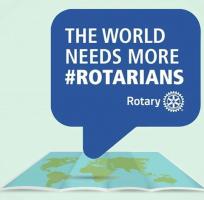Rotary Foundation
The Rotary Club of Wrington Vale supports many local, regional, national and interntional charities. Very importantly, we also support Rotary International's own charity - The Rotary Foundation.
The Rotary Foundation is Rotary’s own and only charity and in 2016/17 it will be celebrating its centennial anniversary. Former Rotary International President Arch Klumph’s idea for an endowment fund dedicated to ‘Doing Good In The World’ planted the seed for The Rotary Foundation in 1917.That one idea and an initial contribution of $26.50 set in motion a powerful force for good that has transformed millions of lives around the globe over the decades.
Over the last 100 years, the Foundation has spent over $3 billion on humanitarian programmes across the world. This includes spearheading the movement to eradicate polio across the world, as well as facilitating projects which address Rotary’s Six Areas of Focus.
The mission of The Rotary Foundation is to enable Rotary members to advance world understanding, goodwill, and peace through the improvement of health, the support of education, and the alleviation of poverty. The Foundation is a not-for-profit corporation supported solely by voluntary contributions from Rotary members and friends of the Foundation who share its vision of creating a better world. This support is essential to make possible projects, funded with Foundation grants, that bring sustainable improvement to communities in need.
The work of Rotary begins in the community, and every community has its own unique needs and concerns. While we serve in countless ways, we’ve focused our efforts in six key areas to maximise our impact. These areas encompass some of the world’s most critical and widespread humanitarian needs, and we have a proven record of success in addressing them.
Rotary's Six Areas of Focus
- Peace and Conflict Resolution. Through our partnerships with several leading universities, Rotary Peace Fellows develop the skills to strengthen peace efforts, train local leaders to prevent and mediate conflict, and support long-term peace building in areas affected by conflict.
- Disease Prevention and Treatment. We aim to improve and expand access to low-cost and free health care in underdeveloped areas. Our members educate and mobilise communities to help prevent the spread of major diseases such as polio, HIV/AIDS, and malaria. Many of our projects ensure that medical training facilities are located where the workforce lives.
- Water and Sanitation. Our projects give communities the ability to develop and maintain sustainable water and sanitation systems and support studies related to water and sanitation.
- Maternal and Child Health.We provide immunisations and antibiotics to babies, improve access to essential medical services, and support trained health care providers for mothers and their children. Our projects ensure sustainability by empowering the local community to take ownership of health care training programs.
- Basic Educationand Literacy. Our goal is to strengthen the capacity of communities to support basic education and literacy, reduce gender disparity in education, and increase adult literacy.
- Economic and Community Development. We carry out service projects that enhance economic and community development and develop opportunities for decent and productive work for young and old. We also help strengthen local entrepreneurs and community leaders, particularly women, in impoverished communities.
Polio this week - As of 5 June 2013
- The Independent Monitoring Board (IMB) for polio eradication has underscored that stopping polio transmission by end 2014 is a realistic prospect. In the report of its 7-9 May meeting, the IMB commended the programme on the fundamental changes that have transformed the effort into a more responsive and coordinated health initiative, which has brought polio to the lowest levels ever. The IMB put forward key recommendations to address fundamental changes that are still needed. In particular, communications and social mobilization across the Global Polio Eradication Initiative (GPEI) needed to be strengthened to generate genuine demand for polio vaccinations; a final decision is urgently needed whether to introduce inactivated polio vaccine (IPV) early in the remaining endemic countries prior to the universal introduction of IPV outlined in the new Polio Eradication and Endgame Strategic Plan 2013-2018; and a more focused and responsive global management approach is needed to ensure countries receive the most optimal support possible. For more, including a link to the full report, please click here.
- Wild poliovirus type 1 (WPV1) was isolated from environmental sampling from Israel, as part of routine environmental surveillance in the country. Virus has been detected in sewage only no case of paralytic polio has been reported. Genetic sequencing and epidemiological investigations are ongoing to determine the origin. Health authorities have launched a full epidemiological and public health investigation, actively searching for potential cases as well as for any un-immunized persons. More.
- Outbreak response in the Horn of Africa is continuing, following detection of WPV cases in Somalia and Kenya. Two large-scale campaigns have already been implemented in Somalia, with overall good coverage and community participation reported. See Horn of Africa section for more.
Wild Poliovirus (WPV) cases
|
Total cases |
Year-to-date 2013 |
Year-to-date 2012 |
Total in 2012 |
|
Globally |
45 |
67 |
223 |
|
- in endemic countries |
36 |
64 |
217 |
|
- in non-endemic countries |
9 |
3 |
6 |
Case breakdown by country
| Countries |
Year-to-date 2013 |
Year-to-date 2012 |
|
Date of most |
||||||
| WPV | WPV3 | W1W3 | Total | WPV1 | WPV3 | W1W3 | Total | |||
| Pakistan | 10 | 10 | 14 | 2 | 1 | 17 | 58 | 10-May-13 | ||
| Afghanistan | 2 | 2 | 8 | 8 | 37 | 28-Mar-13 | ||||
| Nigeria | 24 | 24 | 28 | 11 | 39 | 122 | 25-Apr-13 | |||
| Somalia | 7 | 7 | 0 | 13-May-2013 | ||||||
| Kenya | 2 | 2 | 0 | 14-May-2013 | ||||||
| Chad | 3 | 3 | 5 | 14-Jun-12 | ||||||
| Niger | 1 | 15-Nov-12 | ||||||||
| Total | 45 | 0 | 0 | 45 | 53 | 13 | 1 | 67 | 223 | 14-May-13 |
| Total in endemic countries | 36 | 0 | 0 | 36 | 50 | 13 | 1 | 64 | 217 | |
| Total outbreak | 9 | 0 | 0 | 9 | 3 | 0 | 0 | 3 | 6 | |
'What We Do' Main Pages:




